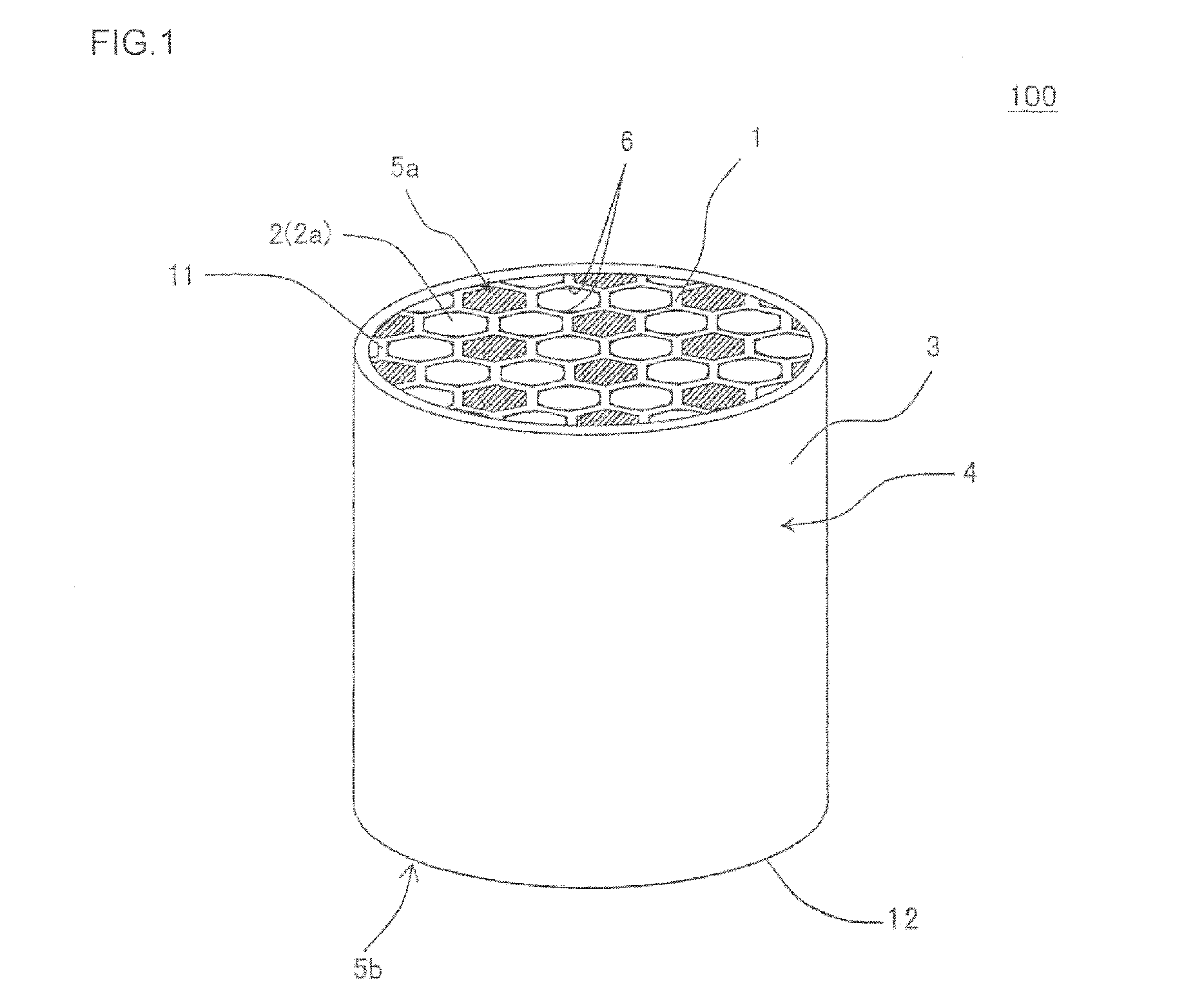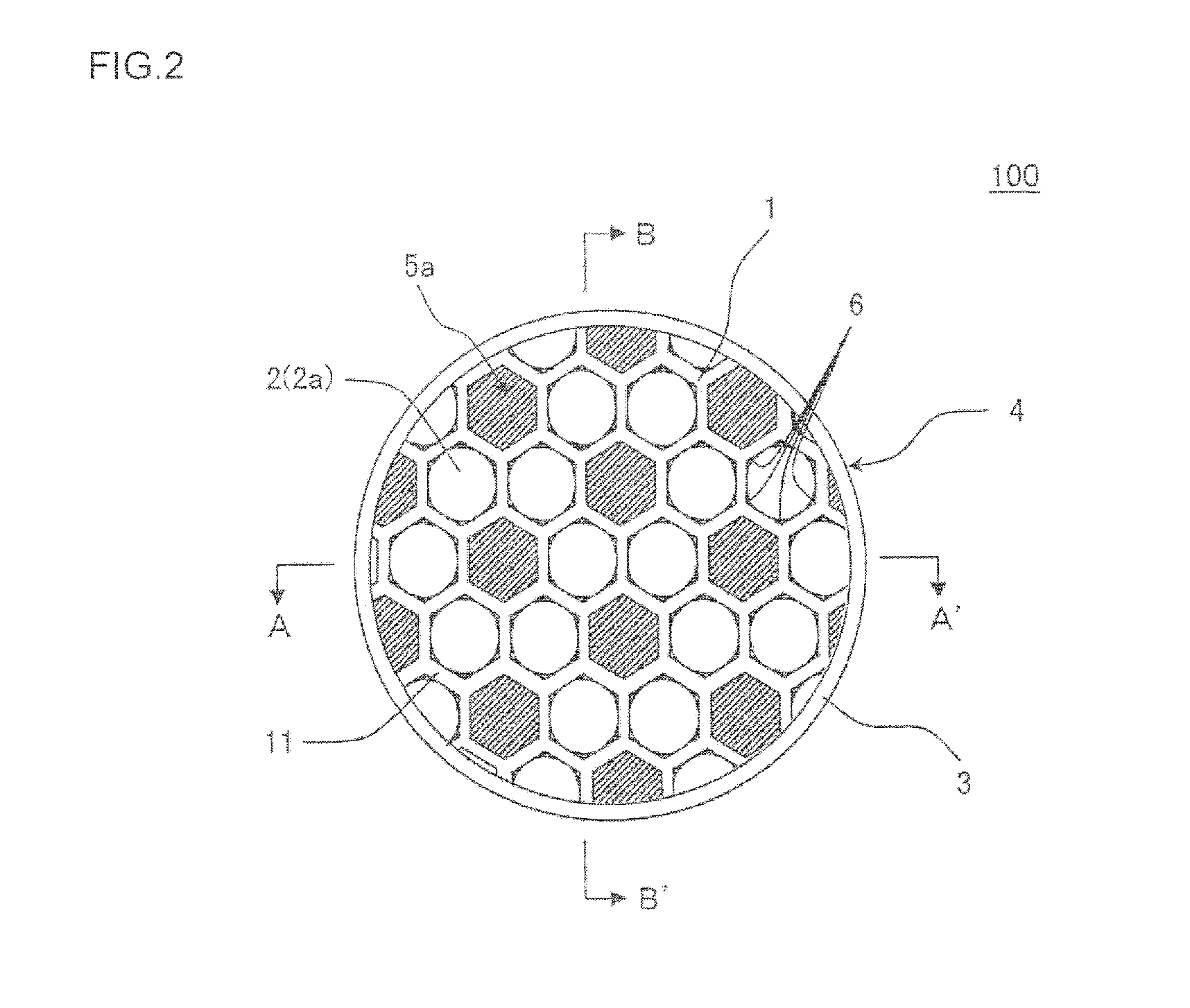Plugged honeycomb structure
a honeycomb structure and plugged technology, applied in the field can solve the problems of easy cracks over the whole honeycomb structure body, disadvantageous low isostatic strength of honeycomb structure body of hexagonal cells, etc., to enhance the isostatic strength of plugged honeycomb structure, and less influence on pressure loss
- Summary
- Abstract
- Description
- Claims
- Application Information
AI Technical Summary
Benefits of technology
Problems solved by technology
Method used
Image
Examples
example 1
[0113]As a ceramic raw material, a cordierite forming raw material (alumina, talc and kaolin) was used. A mass ratio of alumina, talc and kaolin was a mass ratio at which cordierite was obtained after firing. The ceramic raw material was mixed with a binder (methylcellulose) and water, to obtain a ceramic forming raw material. The obtained ceramic forming raw material was kneaded by using a kneader to obtain a kneaded material.
[0114]Next, the obtained kneaded material was formed by using a vacuum extrusion forming machine, to obtain a formed honeycomb body including partition walls with which hexagonal cells were formed. For the hexagonal cells, as in a plugged honeycomb structure 100 shown in FIG. 1, FIG. 2, FIG. 3A, FIG. 3B, and FIG. 4A to FIG. 4C, all hexagonal cells 2 had the same shape. In this formed honeycomb body, all corner portions to become specific corner portions were provided with reinforcing portions 6 at formation. This is indicated as “all the specific corner portio...
examples 2 to 10
[0135]The procedures of Example 1 were repeated except that “an area ratio (%) covered by reinforcing portions” and “arrangement of the reinforcing portions” were changed as shown in Table 1, to manufacture plugged honeycomb structures. The obtained plugged honeycomb structures were subjected to evaluation of “an isostatic strength”, “an initial pressure loss”, “a capacity of deposited ash”, and “a pressure loss at the ash deposition”. The evaluation results are shown in Table 1. Additionally, in Example 2, specific corner portions corresponding to 80% of the specific corner portions of hexagonal cells were provided with reinforcing portions. In Example 3, specific corner portions corresponding to 50% of the specific corner portions of hexagonal cells were provided with reinforcing portions. In Example 3, when the specific corner portions were adjacently arranged to share one side constituting each of the hexagonal cells, the specific corner portions were provided with the reinforci...
example 11
[0141]The procedures of Example 1 were repeated except that a hexagonal cell shape was formed as in a plugged honeycomb structure 200 shown in FIG. 6, FIG. 7A and FIG. 7E, to manufacture a plugged honeycomb structure. The obtained plugged honeycomb structure was subjected to evaluation of “isostatic strength”, “initial pressure loss”, “capacity of deposited ash”, and “pressure loss at the ash deposition”. The evaluation results are shown in Table 2. In the plugged honeycomb structure of Example 11, a shape of outflow cells was a regular hexagonal shape having one side of 0.85 mm. Moreover, in a shape of inflow cells, among six sides of a hexagonal shape, a length of each of three sides adjacent to the outflow cells via partition walls (i.e., long sides) was 0.85 mm, and a length of each of three sides adjacent to the inflow cells via partition walls (i.e., short sides) was 0.50 mm. In the plugged honeycomb structure of Example 11, all corner portions that became specific corner port...
PUM
| Property | Measurement | Unit |
|---|---|---|
| thickness | aaaaa | aaaaa |
| thickness | aaaaa | aaaaa |
| thickness | aaaaa | aaaaa |
Abstract
Description
Claims
Application Information
 Login to View More
Login to View More - R&D
- Intellectual Property
- Life Sciences
- Materials
- Tech Scout
- Unparalleled Data Quality
- Higher Quality Content
- 60% Fewer Hallucinations
Browse by: Latest US Patents, China's latest patents, Technical Efficacy Thesaurus, Application Domain, Technology Topic, Popular Technical Reports.
© 2025 PatSnap. All rights reserved.Legal|Privacy policy|Modern Slavery Act Transparency Statement|Sitemap|About US| Contact US: help@patsnap.com



